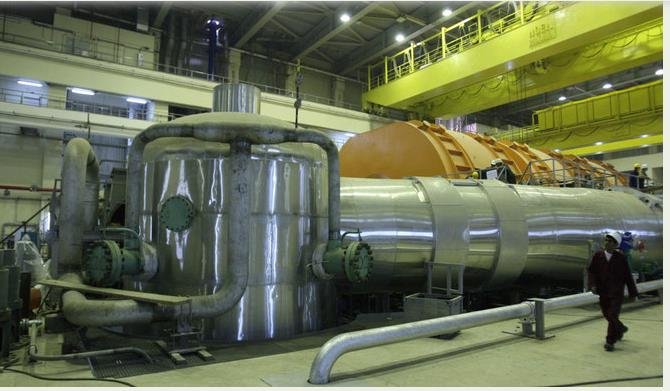
Iran has deepened its commitment to supplying arms for Russia’s assault on Ukraine by agreeing to provide a batch of medium-range missiles, as well as large numbers of cheap but effective drones, according to US and Iranian security officials.
The surface-to-surface missiles are designed to supplement the severely run-down stock of Russian missiles, as part of a bid to systematically destroy Ukraine’s electricity infrastructure ahead of a brutal winter.
The UK defence secretary, Ben Wallace, flew to Washington at short notice to discuss the dangerous new phase in the war, share intelligence on Iran’s involvement and discuss what package of new air defence can be provided to Ukraine to help the nation stave off the attacks.
The Iranian sale of missiles to Russia took place following a series of meetings including one in Moscow on 18 September and another on 6 October when Iran’s first vice-president, Mohammad Mokhber, two senior officials from Iran’s powerful Revolutionary Guards and an official from the Supreme National Security Council visited Moscow.
Reuters cited an Iranian official briefed on the October trip saying: “The Russians had asked for more drones and those Iranian ballistic missiles with improved accuracy, particularly the Fateh and Zolfaghar missiles family.”
The two short-range missiles are capable of striking targets at distances of 300km (185 miles) and 700km (435 miles) respectively.
Iran on Tuesday repeated its denial of selling drones to Russia, and called for talks with Ukraine to “resolve” the accusations. But Tehran at the same time asserts it is fully entitled to sell arms abroad since the restrictions on arms sales contained in the 2015 Iran nuclear deal expired in 2020. The US, France and the UK say missile sales would be in breach of the nuclear deal.
Ukraine’s foreign minister, Dmytro Kuleba, said on Tuesday that he had advised that his nation break off all diplomatic ties with Iran, saying Ukraine would not tolerate Iran’s “meanness and lies” on the issue.
The White House has straightforwardly accused Iran of lying about the drone sales, but has been more circumspect about the missile sales. Western officials say hundreds of drones have been supplied, and were in the short term being used to destroy Ukraine’s electricity infrastructure.
Ukrainian intelligence said 1,750 drones, each costing only £20,000 to manufacture, have been delivered. They can be fired from mobile trucks and, despite their slow speeds, are hard to detect until the last minute.
The Ukrainian president, Volodymyr Zelenskiy, last week said Russia is seeking to acquire 2,400 drones from Iran.
The deepening of the Iranian-Russian alliance was first signalled in June when Vladimir Putin visited the new Iranian president, Ebrahim Raisi, in Tehran. They met again on 16 September at the Shanghai Cooperation Organisation, where they revealed they were finalising a new treaty covering trade and security.
Any western determination that Iran is supplying medium-range missiles is a high risk move by Iran, since western officials are already starting to come under severe political pressure to end talks with Iran over the 2015 nuclear deal due to the repression of street protests by women and students.
The Iranian talks are effectively suspended until after the US midterm elections, but even after those Joe Biden will find it impossible to gather support for a renewed deal if Iranian supplied rockets are pounding Ukrainian cities.
The west has worked on the assumption that Iran wants to keep those talks alive and bring about a lifting of crippling western sanctions, but many around the current Iranian leadership want to abandon any pretence of improving relations with the west and instead form a long-term strategic alliance with Russia and China.
The GPS-guided Iranian Shahed 136 drones can fly up to 1,5oo miles launched from trucks outside Ukraine. Through their low cost and sheer numbers, they have become a major and expensive preoccupation for Ukrainian air defence, pulling some of its systems back from the eastern front lines.
They can be combated by small arms, Stinger missiles, GPS jammers, anti-aircraft artillery and the German supplied IRIS-T air defence systems. A western official said there are a lot of colleagues “looking at what the right package might be to support the Ukrainian air defences”.
“Given the size of the nation of Ukraine and the infrastructure and military operation that you want to protect, there is not enough air defence in the world to create a shield to prevent Russian missiles and drones coming into the territory,” said former US general Mark Hertling.
“The drones have a negligible radar signal, so you do not know they are there until that lawnmower is buzzing around 1,000ft overhead. They are coming from all kinds of directions.
“They do fly quite slowly, though, so they are much more susceptible to being shot down by small arms and other systems. The tactics have been using them en masse in the hope some get through.”
The UK raised the issue of the Iranian drones in a meeting with Iranian diplomats on 3 October and UK officials said they are looking at a range of robust responses, which are likely to include a new UN security council resolution and further sanctions.
A formal suspension of the Iran nuclear deal talks is likely to be one of the points of discussion between US officials, and Wallace and UK foreign secretary James Cleverly.
Western officials have predicted the nature of the war will change radically by mid-November when the rains will make most ground manoeuvres impossible.
But they are expecting to see further progress in the south around the city of Kherson before that deadline, given the signs that Russia is starting a partial withdrawal of civilians from the city.












